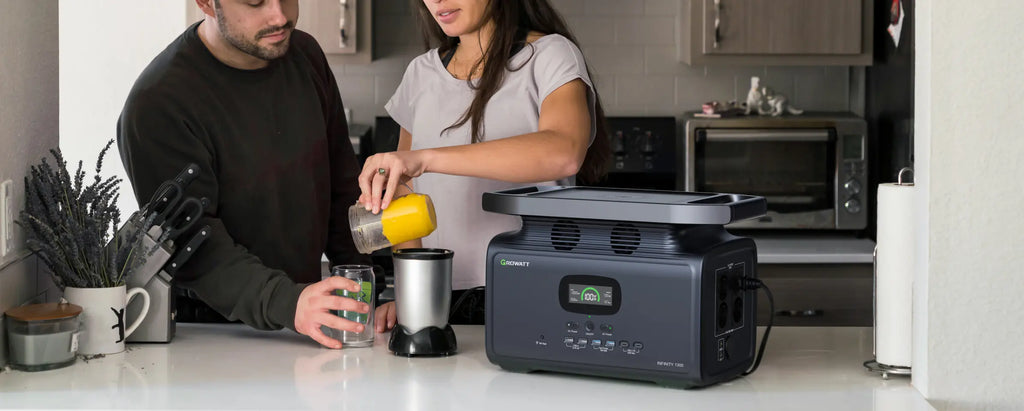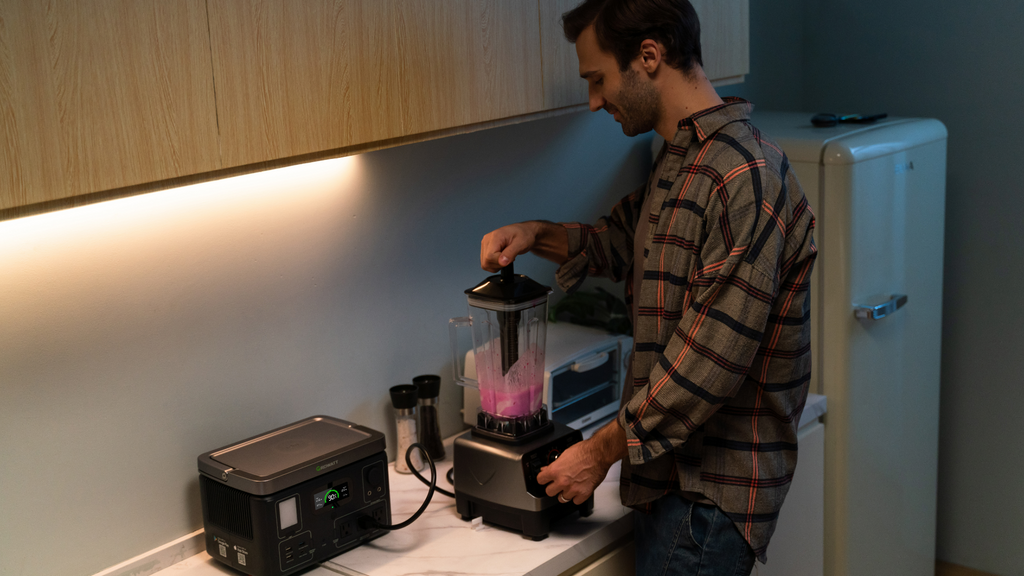The modern world demands an energy assessment of your home in order to understand your home’s contemporary energy consumption. It showcases how many watts are consumed by different devices. This information will help you cut unnecessary power usage. As a result, you will achieve both cutting of your bills and a greener footprint in line with global sustainability efforts.
The question “How Many Watts Does a House Use?” takes the issue off a simple numerical exercise on a journey of a lifestyle that is conscious of the environment. According to statistics from the Energy Information Administration (EIA), the average monthly electricity consumption of residential electricity customers in the United States is about 889 kilowatt hours, which is an average of 29,600Wh per day. Dividing this by 24 hours results in 1,233W of power supply throughout the day. Note that this is an average value. It may be higher than this value at certain times of the day in your house, or lower than this value most of the time, depending on your electrical appliance usage.
This article explains the question about your house wattage consumption, which will help you live a more eco-friendly life.

Understanding Energy Assessment Terminology
The term Watt pays tribute to the great Scottish engineer James Watt, whose work boosted the steam engine and thus led to the Industrial Revolution. A watt in the field of electricity is the unit of measurement for the rate of energy flow.
Think of it as a river of energy, where each Watt measures the speed at which the water (energy) is rushing. This means in a residential setting, it is simply how fast your appliances are either using or producing electricity. To this end, Watt can be more simply explained by saying that it is what fuels a bulb’s mild light and a washer’s vigorous rotation.
Significance in Energy Assessment
Energy assessment always begins by estimating how many watts does a house use per day. Knowing your wattage is kind of showing you how much of the electricity is going to where. These details will help you understand how much it costs to run your home over the period in question. Knowing the watts used by individual appliances is the first step towards efficient use of energy.
Conversion to Kilowatts
The most common base unit for power is a Watt. However, people use the kilowatts (kW) as it is more suited for describing house electricity consumption. This is due to the fact that a kilowatt equals 1000 watts. Hence, these figures are easily readable and understandable, be it on a power bill or an energy monitor.
Calculate Daily Electricity Consumption by Converting Watts to kWh
The conversion of watts into kWh is quite basic and involves simple mathematics. The conversion is crucial in determining how powerful devices are as they burn energy over an interval, usually indicated using kWh on utility bills. Here's how the conversion is carried out:
-
The Conversion Formula:
- The formula is expressed as
- kWh=(Watts×Hours)/1000
-
Applying the Formula:
- For instance, a 100-watt light bulb running for 5 hours would consume:
- Energy (kWh)=(100W×5 hours)/1000=0.5 kWh
-
Online Calculators:
- Numerous online calculators facilitate this conversion. For example, on maxtables.com, by inputting the power value in watts and the duration in hours, you can obtain the energy in kilowatt-hours with a simple click.
-
Practical Application:
- This conversion is instrumental for real-world applications like calculating the cost of running appliances, estimating solar panel energy production, or determining energy savings from energy-efficient devices.
This simple conversion plays a critical role in understanding and managing energy consumption, leading to potential cost savings and a reduction in carbon footprint.

Monitoring Your Energy Consumption
In today’s world, where everybody focuses on energy conservation, taking a step ahead in this direction will be a smart thing to do at home. Regularly checking how much energy you use at home will help you understand your energy needs and guide you on best energy-saving practices. There are several methods to go about this:
1. Energy Monitoring Systems
Invest in an energy monitoring system that offers current data sets with accompanying reports about how much electricity is being used. It is for this reason that these automated systems come preinstalled with user-friendly displays that show the pattern in which energy is being consumed, making it easier for you to spot appliances or times when there is heavy power use. Other high-end monitoring solutions feature predictive analytics that warns of potential overspending while offering remedial measures for cutting down power usage.
2. Smart Meters
Smart meters are being adopted by many utility companies, and they give detailed breakdowns of the energy consumed. Smart meters are different in that they electronically transmit usage data to your utility provider, bypassing physical readings. Moreover, most of these meters have companion apps or online systems that allow you to track your energy use over the years, compare with previous records, as well as setting up energy reduction objectives.
3. Manual Meter Reading
Reading your traditional meter on a daily basis will help you learn how much energy you use at different times of the day. You can track readings from time to time in order to find out the trends and potential for energy savings. It is a rather direct technique requiring dedication, but it could prove very helpful.
4. Online Energy Audits
There are some sites that have energy audit tools that will require you to put the information concerning the type and usage of your home appliance and give you an estimate of the amount consumed. Though less accurate than other means, you may use online energy audits as a fast check of your energy consumption patterns.
5. Professional Energy Audits
You may hire a professional energy auditor who will carry out an entire analysis of your house’s energy consumption pattern. These professionals use specific equipment and methods that are used in analyzing the energy consumed, wastage, and their recommendations towards energy saving.
Of course, the monitoring of your energy usage does not stop at revealing the effect that various appliances or habits have on your energy bill. Also, it serves as an important step toward running a sustainable (or environmentally friendly) household that consumes less energy overall. It provides you with the information required to effect beneficial changes in your wallet and the environment at large.
Common Household Items
Wondering how many watts does a house use per day? Here’s a table illustrating some common household items, their wattage, and an estimation of their watt-hour consumption:
|
Household Item |
Estimated Wattage (W) |
Estimated Daily Consumption (Wh) |
|
Evaporative AC |
2,600W |
31,200Wh (12 hrs) |
|
Heat Pump |
4,700W |
56,400Wh (12 hrs) |
|
Humidifier (13 Gal.) |
175W |
2,100Wh (12 hrs) |
|
Electric Water Heater |
4,000W |
48,000Wh (12 hrs) |
|
Well Water Pump (1/2 HP) |
1,000W |
2,400Wh (2.4 hrs) |
|
Window AC (10,000 BTU) |
1,200W |
14,400Wh (12 hrs) |
|
Light Bulb (Common) |
75W |
750Wh (10 hrs) |
|
Ceiling Fan |
60W |
720Wh (12 hrs) |
|
Tube Light (1500mm) |
22W |
220Wh (10 hrs) |
|
Night Light |
1W |
12Wh (12 hrs) |
|
Coffee Maker |
~1000W |
250Wh (15 mins) |
|
Dishwasher |
~1500W |
1,500Wh (1 hr) |
|
Ceiling Fan |
~75W |
900Wh (12 hrs) |
|
Kettle |
1500W |
750Wh (30 mins) |
- The estimated daily consumption is a rough approximation based on typical usage hours per day.
- Items like the coffee maker and kettle have shorter typical usage times. Hence, their daily consumption is significantly lower despite their high wattage.
The table above illustrates that in any home, most of the consumed energy goes towards heating and cooking. In this case, the watt-hour (Wh) consumption is more precise as it takes into consideration the wattage of the appliance and usage time.

Energy-Saving Tips
In the modern world, where everyone is concerned about saving up on power bills and conserving energy because it is vital for keeping our environment clean; there are various avenues that you can take toward minimizing the consumption of electricity. An interesting way to get there is by using solar power with solar generators or portable power stations. They are excellent green alternatives for converting sunlight into energy, and they don’t cost an arm and a leg.
Here are some more energy-saving tips to consider:
1. Switch to LED Lights
Ninety percent less energy is used to operate LED lights as opposed to the common incandescent bulb. In addition to this, they are energy efficient and last longer than normal bulbs, which means that replacements are not often needed.
2. Use Energy-Efficient Appliances
Seek an appliance with an ENERGY STAR symbol. The symbol signifies energy savings. Such appliances utilize lesser amounts of energy but maintain excellent performance.
3. Employ Smart Technology
These include, among others, smart thermostats and smart power strips, as they will go a long way in helping you manage and reduce the energy consumption in your house.
4. Mindful Usage of Water
Cut back on using hot water. Wash clothes in cold water or take shorter showers with a low-flow showerhead.
5. Unplug Devices When Not in Use
Several electronic devices and chargers still consume power even after being switched off. Disconnecting these appliances or using smart power strips will reduce such ‘phantom’ consumption of electricity.
6. Air Seal Your Home
Sealing your home against air will stop drafts and ensure that you do not have to keep heating or cooling your home excessively, as this is not only expensive but may also result in an uncomfortable temperature indoors.
7. Harness Solar Energy
Using renewable sources is possible through solar generators or portable solar panels. Apart from sustainable power solutions, they are also pocket-friendly.
8. Practice Energy-Efficient Habits
Such small habits as switching off unnecessary lights, utilizing natural sunlight and being cautious in setting the thermostats are important for saving on energy consumption.
9. Regular Maintenance of Appliances
Routine checkups of your HVAC system, water heaters, and major devices make them operate effectively with minimal power consumption.
10. Educate and Involve Family Members
Train family members on the importance of conserving energy and get them involved in conservation methods. Involving all in this process can make a big difference in lowering the amount of energy that is used for domestic purposes.
Implementing these energy-saving tips and using solar generators (or portable power stations) would help to save money on the cost of energy as well as make a positive contribution towards a healthier environment that is less polluted.
FAQs
1. How Many Watts Does an Average Home Use?
The wattage a home uses can vary based on several factors, including the size of the home and the number and efficiency of appliances used. On average, a home in the U.S. uses about 11,000 kWh per year).
2. How Many Kilowatts Does a 2000 Square Foot House Use Per Day?
Energy consumption in a 2000-square-foot house depends not on the sizes but the numbers and efficiency of electrical appliances.
3. How Many kWh Does a 1000 Sq Ft House Use?
Also, a 1000 sq ft house’s kWh usage depends on the type of devices installed there as well as its owners’ lifestyle. The average annual energy consumption for a home of about 1000 square feet is roughly 8,500 kWh, which is approximately 23 kWh per day.
These figures represent average values and can vary based on the efficiency of devices, insulation, the habits of people in the house, and even outdoor conditions. In order to obtain accurate data on the consumption, it is advisable that you contract a professional energy audit.

Final Thoughts
This article provides some tips on making a household eco-friendly without necessarily looking into cost savings. Understanding how many watts does a house use per day makes you take sustainability into your own hands.
The question “How many watts does a house use?” is explained, giving information that will allow people to consciously take environmental decisions. By embracing renewable energy sources and conserving energy, we will be saving the environment for the future.






